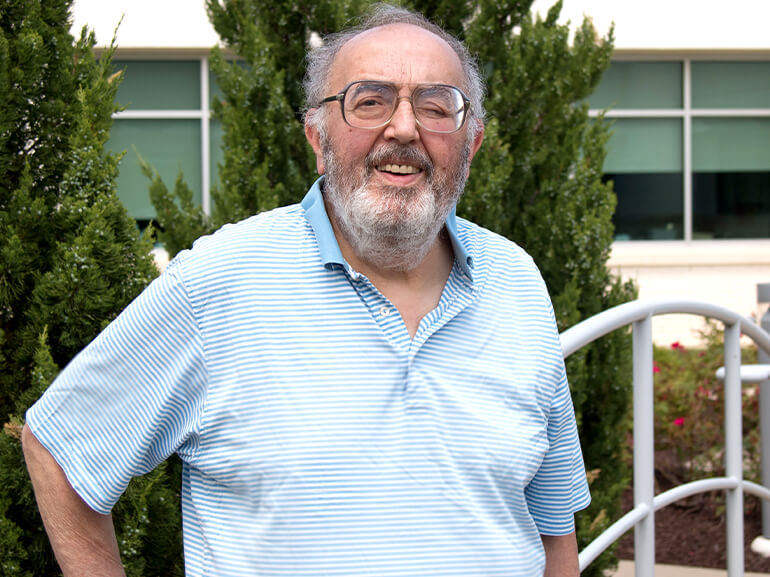Bill Riccio's story

When COVID Requires Full-Spectrum Care
When 81-year-old Bill Riccio collapsed at home, he had no inkling it was the beginning of a fight against the coronavirus.
His wife, Charmaine, called 911 and he was rushed to the hospital, where tests revealed the retired printer was positive for COVID-19. As the disease attacked his lungs, they filled with fluid. His legs gave out due to lack of oxygen. Bill had to be placed on a ventilator.
“I was afraid I was going to lose him,” Charmaine said.
Although he was liberated from the vent within two weeks, he still needed high levels of oxygen delivered by a nasal tube. Significantly weakened, he was unable to walk or take care of personal needs.
Charmaine thought Regency Hospital Cleveland West was the next best step for her husband’s recovery.
Bill arrived in mid-May, one of the hospital’s first COVID-19 recovery patients and eager to begin regaining strength and independence. His primary goals were to heal, breathe independently and get back home. A physician-led team, including nurses and therapists, created a plan to get him there.
“Respiratory therapists and nurses helped me get off oxygen and made me feel better,” Bill said. “I found the whole place very relaxed.”
To build lung capacity, Bill performed deep breathing and chest exercises and used a device with a small ball in a tube that moved higher with more vigorous puffs of air. He said it was like a game. Within a week and a half, Bill discontinued oxygen support.
Simultaneously, physical and occupational therapists deployed a specialized mobility program, a series of small movements that retrain muscles following long illness. Therapists got Bill into a chair to rebuild his core. They worked through range of motion exercises and used light hand and leg weights to increase stamina.
Occupational therapists retrained his arms and hands to perform daily living activities, such as brushing teeth and combing hair. The only thing he wouldn’t do is shave.
“I’ve never had a beard before and I’m going to keep it,” Bill said. “It’s my coronavirus beard!”
Pharmacists monitored medication and calibrated doses as he improved. Dietitians created a meal plan rich in healing nutrients, restoring the body after its viral fight.
Due to visiting restrictions in place for the safety of patients and staff, Charmaine couldn’t be at Bill’s side. As a retired licensed practical nurse, she understood. Still, it was difficult. Daily staff-arranged phone and video calls put her mind at ease.
Growing stronger, Bill used a wheelchair to navigate the grounds and hallways.
“It’s so beautiful here, and everyone is so good to me, it was like being on vacation,” he said with a laugh. “Even the food was good!”
Bill felt better, but was still weak from the battle with COVID-19. He continued to need help standing, walking and negotiating stairs, but after three weeks, Bill was ready for the next stage of his recovery.
“The vacation’s over,” Bill said with a laugh. “I’m ready to work on my rehab and get home to my wife."
In early June, he arrived at the Cleveland Clinic Rehabilitation Hospital, Avon, another part of Select Medical’s continuum of care. He was that hospital’s first COVID-19 recovery patient.
Bill wanted to walk, become independent with self-care and get back to the activities he and Charmaine enjoyed, such as going to the zoo and local parks. To meet that goal, physical therapists used seated and standing exercises and therapy bands to enhance endurance and leg strength. Bill began walking 50 feet with a rolling walker. Over time, he went more than 200 feet with little help.
One moment that stands out to Bill is when he was able to pull his legs in and out of bed by himself. Although it seems like a small feat, it was monumental for someone once too weak to do it.
In occupational therapy, Bill worked on dressing, bathing, toileting and grooming himself. He enjoyed a shower for the first time in six weeks. It was good to feel “normal” again, Bill said. His occupational therapists also introduced an exercise program – alternating dumbbells, resistance bands and an arm bike – to increase upper body strength. As the weather warmed, they moved therapy outside, which thrilled Bill.
Therapists taught him conservation strategies so he would have energy for visits to a park or nature trail. Preparing for the return home, therapists taught how to get around his house with a walker.
Two weeks of working toward his rehabilitation goals and Bill was finally reunited with Charmaine. He couldn’t wait to take a long drive through the park and eat a home-cooked meal – although he said the food at the hospital was great, too.
Bill is grateful to be alive and thankful for the care he received at each hospital that treated him.
His advice to others fighting a similar battle is to work hard and listen to the care team. “The staff is here to help you,” he said. “They know how to get you back on your feet.”